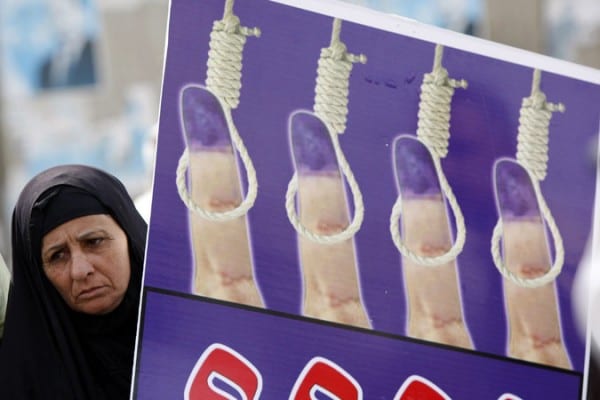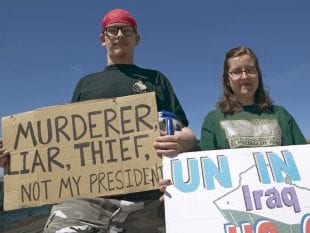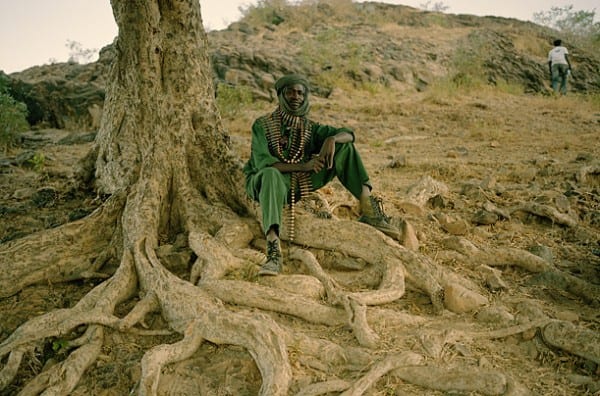U.S. military occupations typically have two aspects, which are, at least theoretically, destructive and productive respectively. The classic U.S. occupation—the one held up as the model by those urging more—was that of Japan, from 1945 to 1952. Its two main missions were “demilitarization” following defeat in war and “democratization.” The latter meant the acceptance of a U.S.-dictated new constitution and at least the appearance of popular rule, and general incorporation into the U.S.-led imperialist camp.
Before and during the occupation of Iraq beginning in 2003, some neocons and President Bush himself offered this supposedly grand success story as the template for that project. (John Dower, a leading scholar on the Japanese occupation, pointed out from before the war the absurdity of assuming that the course of events in an advanced, industrialized country of ethnically homogeneous people could be replicated in a developing, ethnically and religiously divided society like Iraq. Bush, he argued, was misusing historical analogy for propaganda’s sake.)
The U.S. formally ended its occupation of Japan, while maintaining a vast military presence, in 1952. The economy, largely due to U.S. military special procurements, had finally revived to the 1937 level during the Korean War, then grown to 150% of that level by 1952. There was stability; labor demonstrations and protests against U.S. bases were common and sometimes violent, but there was nothing remotely resembling civil war. It surely was a success story, from Washington’s point of view, if not necessarily from the point of view of the Japanese obliged to forego neutrality in the Cold War.
Witness now, eleven years after the Iraq invasion, two and half years of the Pentagon’s sulky withdrawal, the fruits of that imperial project. Where is the demilitarization, the pacification, the law and order? Where is the “democracy,” or even any credible claim to central authority?
The lid that the secular Baathists had kept on the simmering historical conflicts between Shiite and Sunni, Arab and Kurd, religious and irreligious, was blown off by the occupier, who presided over the de facto division of the country into a quasi-independent Kurdistan seeking ever more autonomy, and the rest of Iraq divided through ongoing ethnic cleaning into exclusively Shiite and Sunni Arab communities.
Estimates of civilian deaths caused by the war between 2003 and 2011 are as high as over half a million. Over half the country’s Christians have fled. Over four out of twenty-three million Iraqis have fled the country or are internal refugees. The position of women in society has obviously declined; today headscarves and conservative attire are, if not legally mandatory in public, necessary to escape hostile attention. TheGuardian reported in 2007 that Iraqi women’s lives had “become immeasurably worse, both rapes, burnings and murders a daily occurrence.” Gay people have it worse. A 2012 Reuters piece notes that while “many gays…had been able to live fairly comfortably in Iraq under Saddam’s largely secular rule,” hundreds have been murdered since the invasion and regime change of 2003—14 young men in eastern Baghdad alone in three weeks in 2012.
According to a recent article in Lebanon’s Daily Star, entitled “Once an Arab model, Baghdad now the world’s worst city”: “Massive concrete walls, designed to withstand the impact of explosions, still divide up confessionally mixed neighborhoods [in the capital of Baghdad], while the government sits in the heavily fortified Green Zone, which is also home to parliament and the U.S. and British embassies, access to which is difficult for ordinary Iraqis…”
According to Amir al-Chalabi, head of an NGO working to improve Baghdad urban services, the city which was once the wonder of the world “has become deserted, and it suffers from instability. At night, it turns into a ghost town because of the lack of lighting.” The standard of living attained under the vilified Baathists has collapsed, and while the oil sector has revived, it provides little employment, now (if we can believe the CIA) at 15%.
The U.S. game plan in Iraq was not to install what would look like a multi-party democratic system post-haste; Paul Bremer, commissar of the “Coalition Provisional Authority in Iraq” from May 2003 to April 2004, publicly opined that a rush towards democracy might damage U.S. interests. (He had initially said, “We’re going to be running a colony almost.”) It was not U.S. benevolence but massive pro-democracy, anti-occupation demonstrations that forced the U.S. to gradually allow “free” elections (but minus the banned Baathist party, how could they be free?) and the more or less formal transfer of sovereignty in 2009.
The regime of Nuri al-Maliki midwifed into power by the U.S. is corrupt, dysfunctional, and unpopular. Sympathetic to and influenced by neighboring Shiite Iran, it has avoided complete U.S. domination. (It does not, for example, support the U.S. policy of toppling the Syrian regime.) But it is now appealing for U.S. aid in repressing its foes and is dependent on the U.S. for aid. The U.S. is providing $14 billion in F-16 fighter jets, Apache attack helicopters, Hellfire missiles and reconnaissance drones, and al-Maliki can’t bite the hand that feeds him.
The regime is dominated by religious-sectarian (as opposed to more secular) Shiites who have elbowed aside top Sunni officials (on grounds of “terrorism”) and provoked a massive resurgence of Sunni resistance in the vast province of Anbar . That is where the famous “surge” of 2007 occurred: U.S. forces and Sunni mercenaries united against al-Qaeda, repressing them temporarily.
But all for naught. The al-Qaeda split-off faction called Islamic State of Iraq and the Levant (ISIS) has in recent days rapidly and dramatically taken the cities of Fajullah (site of the deadliest battle U.S. troops have fought since Da Nang, in November 2004), Tikrit (where government troops surrendered to ISIS at their officers’ command), and Mosul. Tens of thousands of Iraqi Christians who had taken refuge in the latter city are now fleeing again for their lives.
ISIS now controls territory larger than Israel and Lebanon combined. The U.S. successfully, at the cost of 4488 U.S. soldiers’ lives, transformed a secular modern country in which al-Qaeda had no significant presence, and was seen as a terrorist threat to the Baathist state, into an al-Qaeda base a million times the size of bin Laden’s puny training camps in Afghanistan.
I wonder what extra dimension of meaning this adds to the many veterans of that imperialist war, effectively brainwashed at some point to think that Saddam Hussein and Osama bin Laden were comrades in arms, and that by toppling Saddam they’d dealt a big blow to al-Qaeda terrorism.
Instead, with the steady inspiring echo of “USA! USA! USA! USA! USA! USA!” in the background, their actions inflated bin Laden’s small group into the welter of jihadi armies now controlling sections of at least seven countries.
There is no end to the war launched by George W. Bush in 2003. No end to the pain nor the national humiliation. There is none of the demilitarization or democratization of the “successful” Japanese model. Secretary of State Colin Powell told George W. Bush in the war planning stage that the Pottery Barn rule pertained: “If you break it, you own it.” The U.S. has broken Iraq, and now awkwardly shares ownership with Iran, which Washington’s been trying to break for years. The war was a total disaster, a catastrophe, a colossal crime that the Obama administration refused from the get-go to investigate and punish. It is hard to see how it even enhanced the global position of U.S. imperialism; it has not even been a great boon for the energy companies. Its chief historical function has been to sicken and terrify the world, convincing it that that the U.S. is run by madmen. Don’t you dare fuck with us, is the message, because we are really crazy!
And witness now, eight years, eight months and four days after the invasion of Afghanistan, the fruits of that other imperial project. Let us ask the same questions. Where is the demilitarization, the pacification, the law and order? Where is the “democracy,” or even any credible claim to central authority?
The cruel peace that the Taliban imposed on Afghanistan (or at least, 90% of it) from 1996, following eighteen years of incessant civil war, was also destroyed by the occupier from late 2001. Disdaining to distinguish the Taliban from al-Qaeda, the U.S.-Coalition forces bombed them both, causing the Talibs on the plea of tribal elders to abandon the cities including their headquarters of Kandahar and fade into the countryside to regroup and fight another day. Al-Qaeda camps were leveled and an unknown quantity of these militants escaped into Pakistan, along with Taliban who quickly organized support in the latter country, which is now—thanks to the U.S. invasion of its neighbor—plagued with its own Taliban spin-offs fighting the Islamabad regime.
At least 20,000 civilians are thought to have died as a result of the ongoing war. But the Taliban has steadily regained strength and is now capable even of bold strikes in Kabul. It has forged alliances with erstwhile foes such as Hezb-e-Islami (headed by former CIA asset Gulbuddin Hekmatyar). Its success has persuaded military intelligence analysts and top generals that the Afghan War can’t be won militarily but there must be a negotiated settlement with the Taliban. (This is notwhat they were saying in the first years of the hopeless war, but a conclusion they’ve rationally drawn no doubt realizing that for many, many Afghans, the Taliban is far less onerous than the western infidel presence.)
Missile strikes “accidently” wiping out wedding parties. Night time home raids—doors kicked in and all. Drone strikes which, whether or not they hit innocent civilians, terrorize whole regions along the Afghan-Pakistan border causing sleepless nights, heart attacks, miscarriages… This terror-war causes Afghan parliamentarians to walk out and protest every so often. It causes current President Hamid Karzai (if only to affect a strident nationalism and save his own political ass) to periodically lash out at the U.S. The indifference of the foreign troops to Afghans’ lives and perceived insults to Afghan culture have produced the ongoing wave of “green on blue” attacks. In the crucible of war, U.S. trainers and the Afghan soldiers they train—the friendliest forces—have reached a toxic level of mutual contempt.
The U.S.-subsidized Afghan National Army, designed to establish and maintain peace, theoretically has 200,000 men (versus an estimated 25,000 Taliban). It is trained by the most modern army in the world. But its annual desertion rate is around 25%, and in serious encounters with the Taliban it’s had a tendency to crumble leaving most of the fighting to U.S. forces. It’s unlikely that, as the number of these U.S. forces reaches 10,000 or even zero (an unlikely though possible, as occurred in Iraq) and the Afghan army assumes full responsibility to handling the “insurgency,” the fighting will appreciably abate.
And democratization in Afghanistan? From the Loya Jirga farce in 2002, in which the U.S. envoy, Afghan-American State Department mentee of Paul Wolfwitz thrust the CIA asset down the Afghans’ throats, to the last election in 2009 so plainly fixed to favor Karzai that Peter Galbraith, a U.S. diplomat sent by the UN as a special envoy responsible for elections monitoring, was obliged to resign in protest. Elections in Afghanistan have been mere theatrical events, producing media images of inked thumbs and lines of voters, designed to legitimate the occupation.
Isn’t it wonderful, we’re supposed to think—whatever else has gone a little wrong—that the Afghan people can finally enjoy democracy? Soon another CIA asset, the winner in the last rigged balloting, Abdullah Abdullah, will ascend to power (or such power as is allowed him) having assured his sponsors that yes indeed, he will sign the agreement for the maintenance of U.S. military presence beyond this year, as demanded by the Obama administration.
As for women coming out from “behind the burqa” (the traditional Pashtun female outfit) thanks to the liberating progressive introduced by foreign occupiers? This is nowhere in sight. The current leadership shares the extremely conservative patriarchal mindset towards women we see in the Taliban. Many women remain in prison for the crime of deserting their husbands or refusing their parents’ marriage choices. The occasional death penalty decision meted out from the Afghan Supreme Court for such offenses as alleged conversion to Christianity tells us much about progress of “freedom” acquired under U.S. tutelage over the last dozen years.
No. The most creative defense lawyer trying to defend these two occupations—these twin crimes against humanity—will be hard-pressed to do so, or even to defend them as ultimately vindicated by results. The results, it turns out are horrific.
These occupations, conducted in the name of the people of this country, are a national shame. But they were not the decision of the people, however the people may have been misled by warmongers’ disinformation. They resulted from decisions based on geopolitical calculations underlined by an amoral and brainless commitment to U.S. exceptionalism, including the right to slaughter without any international legal consequences.
The consequences are unfortunately not felt at the Hague, in the International Court of Justice that the U.S. refuses to join (on the straightforward grounds that U.S. forces must never be tried by foreigners, possibly falling victim to anti-American sentiment).
The consequences are rather felt in the innumerable ways rage and hatred express themselves, when the most arrogant and vicious attack the most weak and vulnerable. By inflicting such ongoing pain throughout the “Greater Middle East,” those secretly praying for another 9/11 seem hell-bent on provoking one, following their last gangbang in Libya and the abortion of the planned Syria assault last August based (once again) on lies. Their failures never deter them. They know they need never apologize. They are assured of employment as cable news “foreign policy experts,” fawning interviews and sometimes book sales.
These occupations have been failures, even if if judged by the occupiers’ expectations and plans. If judged by common global moral standards, they are world-class atrocities. That they should be followed by an al-Qaeda faction’s conquest of much of Iraq and Syria, and the prospect of a Taliban return to power in Afghanistan, is deeply troubling.
But hardly less so than the prospect of an ongoing U.S. berserker rampage designed to instill fear and obedience in a world less and less inclined to fear, respect or obey the exceptional nation, and the One Percent who drive its global aggression.
GARY LEUPP is Professor of History at Tufts University, and holds a secondary appointment in the Department of Religion. He is the author of Servants, Shophands and Laborers in in the Cities of Tokugawa Japan; Male Colors: The Construction of Homosexuality in Tokugawa Japan; and Interracial Intimacy in Japan: Western Men and Japanese Women, 1543-1900. He is a contributor to Hopeless: Barack Obama and the Politics of Illusion, (AK Press). He can be reached at: gleupp@granite.tufts.edu




